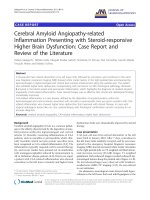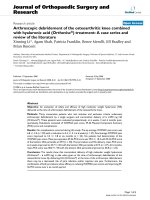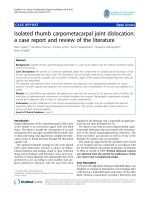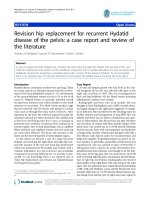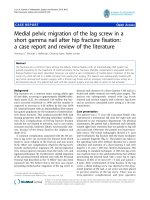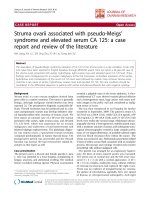Acute myopia and angle closure glaucoma from topiramate in a seven-year-old: A case report and review of the literature
Bạn đang xem bản rút gọn của tài liệu. Xem và tải ngay bản đầy đủ của tài liệu tại đây (1.97 MB, 5 trang )
Rapoport et al. BMC Pediatrics 2014, 14:96
/>
CASE REPORT
Open Access
Acute myopia and angle closure glaucoma from
topiramate in a seven-year-old: a case report and
review of the literature
Yuna Rapoport*, Nancy Benegas, Rachel W Kuchtey and Karen M Joos
Abstract
Background: A case is reported of acute bilateral myopia and angle closure glaucoma in a 7-year-old patient from
topiramate toxicity. This is the second known reported case of topiramate induced acute angle closure glaucoma
and third known reported case of topiramate induced acute myopia in a pediatric patient.
Case presentation: This case presents a 7-year-old who had recently begun topiramate therapy for seizures and
headache. She developed painless blurred vision and acute bilateral myopia, which progressed to acute bilateral
angle closure glaucoma. After a routine eye exam where myopia was diagnosed, the patient presented to the
emergency room with symptoms of acute onset blurry vision, tearing, red eyes, swollen eyelids, and photophobia.
The symptoms, myopia, and angle closure resolved with topical and oral intraocular pressure lowering medications,
topical cyclopentolate, and discontinuation of topiramate.
Conclusion: Acute angle closure glaucoma is a well-known side effect of topiramate, but is rarely seen in children. It
cautions providers to the potential ophthalmic side effects of commonly used medications in the pediatric population.
It highlights the need to keep a broad differential in mind when encountering sudden onset blurry vision in the
primary care clinic, the need for careful consideration of side effects when starting topiramate therapy in a child,
and the need for parental counseling of side effects.
Keywords: Acute angle closure, Drug reaction, Glaucoma, Elevated intraocular pressure, Seizures, Acute myopia
Background
Acute angle closure glaucoma (ACG) from topiramate
toxicity is well reported in adults. The largest case
series was published in 2004 by Fraunfelder et al. [1] of
83 bilateral and 3 unilateral cases. Of these, almost 50%
had been using 50 mg or less of topiramate. Eighty-five
percent of these cases occurred within the first 2 weeks,
with an overall mean of 7 days. There were 5 cases that
occurred within hours when the dose of topiramate was
doubled. These reported findings of most likely occurrence
within 2 weeks and a dosage under 50 mg have been
replicated in another large case series [2].
Topiramate is a sulfamate-substituted monosaccharide
and works via blockage of voltage-gated sodium channels,
hyperpolarization of potassium currents, enhancement of
postsynaptic GABA receptor activity, and suppression of
* Correspondence:
Vanderbilt Eye Institute, 2311 Pierce Avenue, Nashville, TN 37232, USA
AMPA/kainite receptor. It is absorbed rapidly after oral
intake and crosses the blood–brain barrier. It is mostly
excreted in the urine, and has an elimination half-life of
21 hours [2]. In children, it was initially approved in July
1999 as adjunctive treatment for patients 2 years of age and
older with partial onset seizures. Later, it was approved
for seizures associated with Lennox-Gastaut syndrome,
generalized tonic clonic seizures, and as initial monotherapy for partial onset or primary generalized epilepsy.
Topiramate has been approved in the adult population
as preventive therapy for headache and migraine and is
used off-label for these conditions in the pediatric population. In 2011, the pediatric population (0–16 years)
accounted for 7% of total use of topiramate with 2.1 million
prescriptions and 315,000 patients; 81% of pediatric
patients were aged 10–18 years [3].
Acute myopia and angle closure glaucoma are two of
many adverse side effects of topiramate. The underlying
mechanism of acute myopia and acute angle closure
© 2014 Rapoport et al.; licensee BioMed Central Ltd. This is an Open Access article distributed under the terms of the Creative
Commons Attribution License ( which permits unrestricted use, distribution, and
reproduction in any medium, provided the original work is properly credited. The Creative Commons Public Domain
Dedication waiver ( applies to the data made available in this article,
unless otherwise stated.
Rapoport et al. BMC Pediatrics 2014, 14:96
/>
glaucoma is a ciliochoroidal effusion. This leads to ciliary
body edema which causes relaxation of zonular fibers, lens
thickening, and anterior displacement of the lens -iris
complex. The iris bowing forward physically blocks the
drain of the eye, preventing aqueous fluid drainage.
This ultimately causes secondary ACG and myopia.
The ciliochoroidal effusion caused by sulphonamides is
an idiosyncratic response in the uveal tissue, and is dose
independent [4]. The hapten hypothesis postulates that reactive drug metabolites bind to proteins, forming altered
proteins, which are recognized as foreign substances and
incite immune reactions [4]. A patient must receive a
sensitizing dose prior to inciting the immune reaction
with the subsequent dose. The risk of any adverse reaction
to a sulfonamide is 3% [5].
Most common ocular signs of acute ACG from topiramate include abnormal vision, acute intraocular pressure
elevation, acute myopia [6], microcystic corneal edema,
shallow anterior chamber [1], circumciliary congestion,
retinal striae [7], macular folds, choroidal detachments,
and ciliochroidal detachments [8]. Besides topiramate,
other sulfonamides have been reported to cause a similar
clinical syndrome, including acetazolamide [9], sulfasalazine
[10], hydrochlorothiazide [10], and indapamide [4,11]. All
ocular findings are reversible if recognized early and the
drug is discontinued.
Treatment includes immediate discontinuation of topiramate, aqueous suppressants including oral or intravenous
(IV) acetazolamide and IV mannitol, topical beta blockers,
topical carbonic anhydrase inhibitors, topical prostaglandin
analogues, and topical cycloplegics such as cyclopentolate
or atropine, which work by relaxing the ciliary processes
and deepening the anterior chamber. Acute angle closure
usually resolves within 24–48 hours with medical treatment, and myopia resolves within 1–2 weeks of discontinuing the topiramate. If refractory, other measures
reported to be successful include oral/ IV steroids [12],
argon laser peripheral iridoplasty [13], and surgical intervention including choroidal drainage [14], vitrectomy,
cataract extraction/ intraocular lens placement, and other
glaucoma surgeries.
While there are numerous case reports in the literature
of adults presenting with acute ACG from topiramate
toxicity in addition to the two case series mentioned
above, there are very few case reports in children. One
article reports acute myopia in an 8-year-old male with
a 6 diopter myopic shift without ACG [15], and one reports a 5-year-old female presenting with acute ACG
and acute myopia [16].
This is the second known reported case of acute ACG
in a pediatric patient. In this case report, we discuss the
presentation, treatment, and resolution of symptoms, and
discuss a differential diagnosis of pediatric narrow angles
and of elevated intraocular pressure in a child with seizures.
Page 2 of 5
We discuss the potential differences between presentation
and treatment in the adult and pediatric population. We
stress the importance of careful consideration of side effects
when starting topiramate therapy in a child, and the need
for parental counseling of side effects.
Case presentation
History of present illness and review of systems
A 7-year-old female with a history of seizures and headaches presented to the pediatric emergency room (ER)
with acute onset of blurry vision. The morning of presentation, she awoke with blurry vision. She presented to
her pediatrician, who referred her to an optometrist,
where she was refracted to a visual acuity (VA) of 20/20
with a myopic refraction. Visual acuity had been 20/20
at distance previously. Acute myopia is not an altogether
unusual presentation to an optometrist and generally a
new myopia patient does not cause alarm. She continued
to experience worsening vision accompanied with red
eyes, swollen eyelids, excessive tearing and photophobia.
She denied pain, burning, itching, mucus discharge, or
pain with extraocular movements. She denied systemic
symptoms including dizziness, nausea, vomiting, malaise,
neck stiffness, fever, or any focal neurological complaints.
Her last dose of topiramate was 25 mg, 20 hours prior to
presentation.
Past medical, surgical, ocular, medication, social and
allergic history
She had had 3 focal seizures from age 3–4, and had been
treated with levetiracetam until 3 months prior to presentation, having been seizure free for three years. Her
headaches returned, and she had one seizure while in
school, which consisted of dysconjugate eye movements
and brief unresponsiveness. After consultation with her
primary pediatrician and her neurologist, topiramate 25 mg
at bedtime was started 2 weeks prior to presentation. Her
only other medication was cyproheptadine 5 ml at bedtime,
as needed. She had no other medical or surgical history.
Social, allergic and family history was noncontributory.
She was developing normally.
Examination
In the emergency room, her VA without correction was
light perception at 20 feet in both eyes, count fingers at
14 inches in both eyes, and 20/20 at 3 inches in both
eyes. In a complete ophthalmologic examination, vision
is typically tested at distance (20 feet) and at near (14
inches). In this patient’s case, vision was also checked at
2 inches because anteriorization of the lens leading to
acute myopia was suspected. Pupils were 6 mm, minimally
reactive, with no relative afferent papillary defect in either
eye. Extraocular movements were intact. Fields were
constricted 360 degrees to confrontation in both eyes.
Rapoport et al. BMC Pediatrics 2014, 14:96
/>
Intraocular pressure (IOP) measured 40 mmHg in the
right eye and 41 mmHg in the left eye, as measured by
tonometry using a portable tonopen. External exam
was significant for slightly edematous upper and lower
lids. On slit lamp exam, sclera and conjunctiva showed
1+ injection, with conjunctival chemosis temporally bilaterally. There was no corneal edema. The anterior
chamber was diffusely shallow bilaterally. The irides were
round with a regular insertion, without iris bombe. There
was irido-corneal touch as seen by the Van Herick method
[17]. The lenses were clear. Fundus exam showed a pink
and healthy optic disc in both eyes with sharp margins,
with a cup: disc ratio of 0.25. The rest of the fundus examination was unremarkable. No choroidal effusions were
seen.
Treatment
Upon diagnosis with topiramate-induced acute ACG,
she was treated with oral acetazolamide 10 mg/kg × 2
doses, and 5 rounds of topical dorzolamide/timolol and
topical bimatoprost in both eyes. Her IOP decreased to
28 mmHg in the right eye, 29 mmHg in the left eye, and
her symptoms improved. She was no longer photophobic, the eyelid edema had subsided, and VA was now
20/60 at 14 inches. She was discharged home overnight
with topical dorzolamide/timolol twice daily in both
eyes, oral acetazolamide 10 mg/kg three times daily ×
3 days, and topical cyclopentolate three times daily in
the right eye. Topiramate was discontinued and was
placed on her allergy list.
Page 3 of 5
Clinical course
She was followed in the clinic closely. The day after her
initial presentation, her VA was 20/200 in the right eye,
20/150 in the left eye at distance (20 feet), and 20/60 in
the right eye, 20/40 + 3 in the left eye at near (14 inches);
IOP was 23 mmHg in the right eye, 21 mmHg in the left
eye, and all medications were continued. Her slit lamp
examination was unchanged (Figure 1a). In the pediatric
population in whom gonioscopy examination is very difficult, anterior segment optical coherence tomography
(OCT) is a useful way of discerning anatomy of the
angle and the anterior chamber. Anterior segment OCT
(Visante; Jena, Germany) in our patient showed anterior
iris convexity, iridocorneal apposition at the angle, and
an anterior lens vault in both eyes (Figure 1c). All medications were discontinued at eight days after presentation, when her VA was 20/25 + 3, 20/25 at distance, and
IOPs were 12 mmHg in the right eye, 11 mmHg in the
left eye. At her last follow up visit 2 months after initial
presentation, VA and IOP were normal off medications.
She had remained headache and seizure free. Repeat slit
lamp photograph (Figure 1b) and anterior segment OCT
(Figure 1d) demonstrated return to normal anatomy.
The anterior chambers were deep, and there was no
iridocorneal touch, anterior iris convexity, or anterior
lens vault in both eyes.
Conclusion
This case highlights the fact that drug-induced angle
closure, while rare in the pediatric population, should be
Figure 1 Clinical and imaging findings. A. Slit lamp exam of the right eye demonstrating diffusely shallow AC, large pupils, no K edema, and
slightly injected conjunctiva. B. Normal slit lamp photograph of the right eye after resolution of acute angle closure C. Anterior segment OCT of
the right eye demonstrating abnormal anterior iris convexity, iridocorneal apposition at the angle, and an anterior lens vault D. Normal anterior
segment OCT of the right eye demonstrating horizontal iris, no iridocorneal apposition, anterior iris convexity, or anterior lens vault.
Rapoport et al. BMC Pediatrics 2014, 14:96
/>
Page 4 of 5
Table 1 Differential diagnosis of childhood narrow angles
Posterior ‘Pushing’ mechanism
Anterior segment dysgenesis
Corneal anomalies: microcornea, cornea plana/sclerocornea
Anterior rotation of ciliary body
Axenfeld-Rieger syndrome, Peters anomaly, Aniridia
Nanophthalmos, Inflammation (scleritis, uveitis, juvenile idiopathic arthritis)
Ectopia lentis (trauma, homocystinuria, Marfan syndrome,
Ehlers’-Danlos, syndrome, Weill-Marchesani syndrome
Drug-induced
Pupillary block
Pressure from posterior segment
Aphakia
Tumor (retinoblastoma, medulloepithelioma)
Microspherophakia
Exudative retinal detachment
Anterior “Pulling’ mechanism without pupillary block
Contraction of retrolental tissue
Neovascular (tuberous sclerosis)
Persistent fetal vasculature
Peripheral anterior synechiae
Retinopathy of prematurity
suspected in children who present with acute onset of
blurry vision and have features of bilateral acute angle
closure, myopic shift and elevated intraocular pressure.
Other considerations in a child with narrow angles
similarly caused by a ciliochoroidal effusion include
scleritis, uveitis, juvenile idiopathic arthritis, tumors such
as retinoblastoma and medulloepithelioma, and exudative
retinal detachments. A full differential is presented here,
organized by mechanism (Table 1). The patient’s history
of seizures and presentation with elevated IOP is in
hindsight clearly linked to topiramate, but upon initial
consideration those two features could be linked in and
of themselves. Childhood phacomatoses such as Sturge
Weber, Klippel-Trenaunay-Weber Syndrome, WyburnMason syndrome, tuberous sclerosis, and neurofibromatosis I, as well as Aicardi Syndrome, the Ring 14 Syndrome
[18], and CASK mutation [19] all present with epilepsy in
childhood and have different mechanisms of elevating
IOP (Table 2).
A thorough history and examination should eliminate
most of the previous entities from consideration. As this
is the second known reported independent case report
of childhood ACG from topiramate, it is difficult to draw
conclusions as to differences between the clinical presentation and course between children and adults. Since
they are both caused by the same mechanism, the same
course and outcome is assumed to occur. Treatment is
the same as in adults except topical alpha agonists are
contraindicated in children. Further investigation and
reports will help elucidate potential differences between
adults and children.
In comparison with the one other case of pediatric
ACG from topiramate [16], our patient did not present
with headache, nausea, and fatigue, had a slightly
lower IOP (40 vs. 50 mmHg), did not show microcystic corneal edema, but did have iridocornreal touch. In
addition to pressure-lowering medications, a thorough
review of systemic medications should be undertaken
with discontinuation of the most probable causative
agent. A high index of suspicion for drug-induced
causes will allow for a quick diagnosis and complete
visual recovery.
Table 2 Differential diagnosis of elevated intraocular pressure and seizures in children
Aicardi syndrome
Microphthalmos
Agenesis of corpus callosum, depigmented chorioretinal
lacunae
CASK mutation
Anterior segement dysgenesis,
megalocornea
Dystonia, psychomotor retardation, severe, intellectual disability,
scoliosis, mild, dysmorphism, progressive microcephaly
Klippel-Trenaunay-Weber syndrome
Increased episcleral venous pressure
Port-wine stains, venous and lymphatic malformations, soft tissue
hypertrophy of affected limbs
Neurofibromatosis
Anterior segment dysgenesis
Optic nerve glioma, Lisch nodules, café au lait spots, neurofibromas,
freckling of intertriginous areas
Ring 14 syndrome
Unknown
Macular white spots, strabismus, short, stature, microcephaly, scoliosis
Sturge Weber syndrome
Increased episcleral venous pressure
Port-wine stains, ipsilateral leptomeningeal, vascular
malformations
Tuberous sclerosis
Anterior segment neovascularization,
retinal detachment
Retinal astrocytic hamartomas, ash-leaf spots, adenoma sebaceum,
cardiac rhabdomyoma
Wyburn-Mason syndrome
Intraocular hemorrhage
Retinal racemose hemangiomas, arteriovascular, malformation with
dilated and tortuous shunt vessels
Diagnosis Intraocular Pressure Elevation Mechanism Other Clinical Findings.
Rapoport et al. BMC Pediatrics 2014, 14:96
/>
Important clinical pearls of topiramate toxicity induced
angle closure glaucoma were highlighted by this case report. The first presenting sign of acute angle closure from
topiramate toxicity may be blurring of vision bilaterally at
distance with normal vision at near, representing the
myopic shift, and occurs prior to symptoms and elevated
IOP. Eighty five percent of cases of IOP elevation occur
within two weeks of use. Finally, primary narrow angle
glaucoma is rare under 40 years of age, and secondary
angle closure glaucoma, particularly drug-induced ACG,
must be considered in pediatric patients.
Page 5 of 5
9.
10.
11.
12.
13.
14.
Requesting consent statement
Written informed consent was obtained from the patient’s
parent for publication of this case report and any accompanying images. A copy of the written consent is available
for review by the Editor of this journal.
Abbreviations
ACG: Angle closure glaucoma; EEG: Electroencephalogram; ER: Emergency
room; IOP: Intraocular pressure; IV: Intravenous; OCT: Optical coherence
tomography; VA: Visual acuity.
Competing interests
The authors declare that they have no competing interests.
Authors’ contributions
YR was involved in the patient care, performed the literature review, and
drafted the manuscript. NB was involved in the patient care and edited the
manuscript. RK was involved in the patient care and edited the manuscript.
KJ analyzed the data and was involved in the manuscript drafting and critical
revision for content. All parties approved the final manuscript.
Acknowledgment
I would like to take this opportunity to thank the parent and patient for
allowing me to submit this case. Supported in part by an Unrestricted
Departmental Grant to the Vanderbilt Eye Institute by Research to Prevent
Blindness, Inc., New York.
15.
16.
17.
18.
19.
Malagola R, Arrico L, Giannotti R, Pattavina L: Acetazolamide-induced cilio
choroidal effusion after cataract surgery: unusual posterior involvement.
Drug Des Devel Ther 2013, 7:33–36.
Lee GC, Tam CP, Danesh-Meyer HV, Myers JS, Katz LJ: Bilateral angle
closure glaucoma induced by sulphonamide-derived medications. Clin
Experiment Ophthalmol 2007, 35(1):55–58.
Blain P, Paques M, Massin P, Erginay A, Santiago P, Gaudric A: Acute
transient myopia induced by indapamide. Am J Ophthalmol 2000,
129:538–540.
Rhee DJ, Ramos-Esteban JC, Nipper KS: Rapid resolution of topiramate-induced
angle-closure glaucoma with methylprednisolone and mannitol. Am J
Ophthalmol 2006, 141:1133–1134.
Zalta AH, Smith RT: Peripheral iridoplasty efficacy in refractory
topiramate-associated bilateral acute angle-closure glaucoma. Arch
Ophthalmol 2008, 126:1603–1605.
Parikh R, Parikh S, Das S, Thomas R: Choroidal drainage in the
management of acute angle closure after topiramate toxicity. J
Glaucoma 2007, 16:691–693.
Hussein M, Coats DK: Acute transient myopia in a child. Medscape
Ophthalmology 2002, 3. />Lin J, Fosnot J, Edmond J: Bilateral angle closure glaucoma in a child
receiving oral topiramate. J AAPLEFT EYE 2003, 7:66–68.
Van Herick W, Shaffer RN, Schwartz A: Estimation of width of angle of
anterior chamber. Incidence and significance of the narrow angle. Am J
Ophthalmol 1969, 68:626–9.
Zollino M, Seminara L, Orteschi D, Gobbi G, Giovannini S, Della Giustina E,
Frattini D, Scarano A, Neri G: The ring 14 syndrome: clinical and molecular
definition. Am J Med Genet A 2009, 149:1116–1124.
Burglen L, Chantot-Bastaraud S, Garel C, Milh M, Touraine R, Zanni G, Petit F,
Afenjar A, Goizet C, Barresi S, Coussement A, loleft eye C, Lazaro L, Joriot S,
Desguerre I, Lacombe D, DesPortes V, Bertini E, Siffroi JP, de Villemeur TB,
Rodriguez D: Spectrum of pontocerebellar hypoplasia in 13 girls and
boys with CASK mutations: confirmation of a recognizable phenotype
and first description of a male mosaic patient. Orphanet J Rare Dis 2012,
7:18.
doi:10.1186/1471-2431-14-96
Cite this article as: Rapoport et al.: Acute myopia and angle closure
glaucoma from topiramate in a seven-year-old: a case report and review
of the literature. BMC Pediatrics 2014 14:96.
Received: 8 December 2013 Accepted: 25 February 2014
Published: 9 April 2014
References
1. Fraunfelder FW, Fraunfelder FT, Keates EU: Topiramate-associated acute,
bilateral, secondary angle-closure glaucoma. Ophthalmol 2004,
111:109–111.
2. Abtahi MA, Abtahi SH, Fazel F, Roomizadeh P, Etemadifar M, Jenab K, Akbari
M: Topiramate and the vision: a systematic review. Clin Ophthalmol 2012,
6:117–131.
3. Elgin V, Food and Drug Administration: Pediatric focused safety review:
Topamax (topiramate). Pediatric Advisory Committee Meeting. Available at:
[ />Materials/PediatricAdvisoryCommittee/UCM272861.pdf].
4. Senthil S, Garudadri C, Rao HB, Maheshwari R: Bilateral simultaneous acute
angle closure caused by sulphonamide derivatives: a case series. Indian J
Ophthalmol 2010, 58:248–252.
5. Panday VA, Rhee DJ: Review of sulfonamide-induced acute myopia and
acute bilateral angle-closure glaucoma. Compr Ophthalmol Update 2007,
8:271–276.
6. Guier CP: Elevated intraocular pressure and myopic shift linked to
topiramate use. Optom Vis Sci 2007, 84:1070–1073.
7. Sen HA, O’Halloran HS, Lee WB: Case reports and small case series:
topiramate-induced acute myopia and retinal striae. Arch Ophthalmol
2001, 119:775–777.
8. Kumar M, Kesarwani S, Rao A, Garnaik A: Macular folds: an unusual
association in topiramate toxicity. Clin Exp Optom 2012, 95:449–452.
Submit your next manuscript to BioMed Central
and take full advantage of:
• Convenient online submission
• Thorough peer review
• No space constraints or color figure charges
• Immediate publication on acceptance
• Inclusion in PubMed, CAS, Scopus and Google Scholar
• Research which is freely available for redistribution
Submit your manuscript at
www.biomedcentral.com/submit
